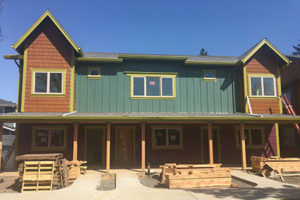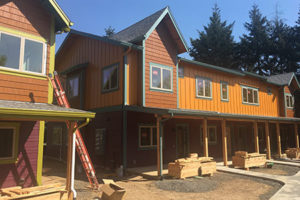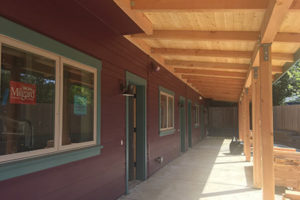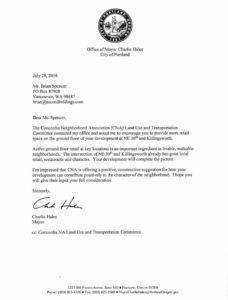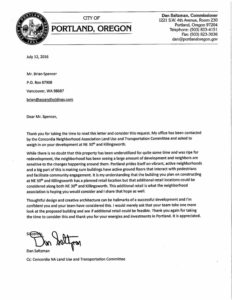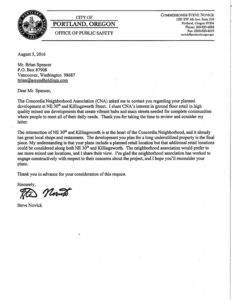Category Archives: Land Use & Transportation
Intentional community nears completion
By Tamara Anne Fowler | CNA Media Team
Organic. Non-GMO. Humane pet food. And now intentional communities are the wave of a green future. One is in next door neighborhood Cully.
An intentional community is a cluster of private homes, with shared interior and exterior spaces, designed to benefit groups of people of all ages. This makes it easy to form clubs, organize child and elder care, and to carpool.
Cohousing facilitates interaction among neighbors and thereby provides social, practical, economic, and environmental benefits.
Members share common amenities such as garden plots, open outdoor areas, tools, a common house for large gatherings, guest rooms and more. They work together to enhance and beautify the landscape. That also creates a sense of being part of something larger than themselves – while they also enjoy private homes to retreat to with family and friends.
Cully Grove is the most recent, full-scale intentional community built by Eli Spevak, the owner of development company Orange Splot LLC, a company named after a favorite children’s book.
Eli partnered with Mark Lakeman. Mark, the owner of Communitecture, has worked with Eli for more than a decade. He started with volunteer work at Dignity Village.
Cully Grove homes were presold to people looking for community living. Some of the residents, including Eli’s family, had previously lived at other cohousing communities.
The development sits on nearly two acres right in the heart of Cully near 42nd Avenue. It is comprised of single-family residences with a large shared garden, bike parking, tool library, interconnecting pathways, and a central grove of trees perfect for planned or spontaneous gatherings.
Eli assembled the Mason Street property in 2014 and 2015. After going through several design iterations with Communitecture, they submitted for permits in late summer 2016 and broke ground in spring 2017.
It offers opportunities for those looking to move either up, or down. “Orange Splot focuses on walkable neighborhoods, where it’s possible to get to transit, groceries, restaurants, schools and parks without always having to jump in a car,” pointed out Amber Turner, principal real estate broker.
The development is within easy walking distance of an Albertson’s grocery store, coffee shops Bison and Beeswing, the five-corner restaurants and food carts, and less than 100 feet from a bus stop. It’s also within easy walking distance of Wellington Park and Rigler and Scott elementary schools.
Tamara Anne Fowler is a copy/content editor, fiction editor and accountability coach. Visit her at EditKitten.com, email her at Tamara@editkitten.com or call 310.359.6038. She would love to hear from you.
CNA Voices: It’s time to join the CNA LUTC
By Garlynn Woodsong | CNA LUTC Committee Chair
It’s an exciting time to be involved with the Concordia Neighborhood Association (CNA) Land Use and Transportation Committee (LUTC). That is fortuitous, because it also just so happens the committee has four current vacancies.
In May, the CNA Board approved sending another comment letter to the city of Portland concerning the Residential Infill Project (RIP). Once again, the board acted upon a recommendation from the LUTC to ask the city to make fourplexes legal within the zones covered by the project, among ot he r re commended changes to staff’s proposed plan.
The board has gone on record with letters recommended by the LUTC such as this multiple times during the past four years. The board’s position on this issue comes from a deep-seated desire for more equitable outcomes from the local housing market.
Recently, the LUTC has worked with the board to apply for a pilot program for residential parking permits to help manage parking demand adjacent to the Alberta Street commercial district.
For many years, the LUTC and board have worked to try to improve bicycling in the neighborhood –and indeed around the city and region – recognizing that bicyclists often leave neighborhood boundaries
Efforts include:
- Working with the city on the 20s Bikeway Project
- Advocating for better bicycle access from downtown through Sullivan’s Gulch to the Columbia River Gorge
- Advocating for more physical diversion to prevent automobile cut-through traffic from damaging the city’s investment in bicycle greenways to provide safe bicycle infrastructure for Portlanders of all ages.
The LUTC is now recruiting new members to bring new energy and to help share the load of working on these exciting topics and more.
If you, or somebody you know who lives, works, or owns property in Concordia – and who is interested in these or similar issues related to land use and transportation – please come to a meeting.
We meet the third Wednesday of each month from 7 to 9 p.m. in the Community Room in the southeast corner of McMenamins Kennedy School. Our next meeting is Wednesday, June 20.
Garlynn Woodsong lives on 29th Avenue, serves on the CNA Board and is an avid bicyclist. He also is a dad who is passionate about the city his son will inherit. He is the planning + development partner with Cascadia Partners LLC, a local urban planning firm. Contact him at LandUse@ConcordiaPDX.org.
Parking takes center stage at general meeting
By Garlynn Woodsong Chair, CNA LUTC
Parking in the neighborhood was the focus of the Concordia Neighborhood Association (CNA) general membership meeting Sept. 6.
Guests for the evening were Jay Rogers from the Portland Bureau of Transportation (PBOT), and Tony Jordan from Portlanders for Parking Reform. They joined a room full of neighbors who came to discuss residential on-street parking.
The PBOT representative walked folks through the current city of Portland policies related to on-street parking, as well as the pilot project currently authorized by city council and underway with residential permit parking in northwest Portland’s Alphabet District.
The current policies – outside of the Alphabet District pilot project – were developed in the 1980s and are largely focused on areas adjacent to downtown that experience large volumes of commuters driving in to park while at work.
These 30-year-old policies were not developed to address parking problems related to large amounts of visitors – for various purposes – at many times through the day and night, week and weekend. The policies were not developed to address the situation of greater residential demand for than supply of on-street parking.
The Portlanders for Parking Reform representative then laid out the basic policy points of the residential on-street parking policy toolbox that city council requested, staff developed, and that city council then failed to adopted last December.
This toolbox was developed specifically to address the parking problems on residential streets in Portland today, including how to handle the needs of residents and visitors in neighborhoods that don’t just see commuter-related parking issues.
The toolbox would empower neighborhoods to work directly with PBOT to develop tailored policies to fit the problems they see in the places where they see them. That includes the ability to design policies to match the results of surveys of on-street parking use on individual block faces.
Neighbors had many questions for both guests about parking. A civilized, neighborly discussion ensued concerning what would happen under a residential permit parking system:
- What the money would be used for
- How a parking benefit district would operate
- How the neighborhood could design policies to mitigate the impact on lowincome residents
- What the equity impact would be on property owners
- Whether the revenue would be primarily to benefit the city or the neighborhood
- Many other related issues
By the end of the evening, it seemed clear that neighbors wanted to see the parking policy toolbox adopted by city council.
Then they would have the option to decide for themselves what parking policies to implement in the neighborhood – when, how and where. That would also include the details of how much it would cost, how the funds would be used and who would pay.
The CNA Board of Directors recommends Portland City Council put the Parking Policy Toolbox back on its agenda, and vote to pass it ASAP.
Attention Neighbors of the Portland International Airport
The Oregon Air National Guard (OANG) and the Port of Portland will co-host a community “Fly Day” on July 8, 2017 at Helensview High School and you’re invited!
The intent of the Fly Day is to demonstrate the ground track and flight profile of the Continuous Descent Overhead Approach flown by 142nd Fighter Wing aircraft, as well as to answer any questions about this expanded procedure.
The Fly Day event is scheduled for July 8, 2017 from 1PM to 3PM. at
Helensview High School
8678 NE Sumner St, Portland, OR 97220
In the event that the winds and weather necessitate an easterly traffic flow, the location will be moved to the Columbia Children’s Arboretum.
Columbia Children’s Arboretum
10040 NE 6th Dr. Portland, OR 97211
A booth will be set-up at the Helensview school on the afternoon of the event to provide updated information.
For more information about the Continuous Descent Overhead Approach procedure follow the link below:
https://popcdn.azureedge.net/pdfs/Continuous%20Descent%20Fact%20Sheet.pdf
For any other questions contact:
Port of Portland – Noise Management Department
Phone: 503.460.4100 (Oregon) / 800.938.6647 (Washington)
E-mail: pdxnoise@portofportland.com
Web: http://www.portofportland.com/Noise_Mgmt_Home.aspx
Land use, transportation & livability update
By Ben Earle Secretary, CNA LUTC
The LUTC plate brims with substantial developments on three issues that will affect Concordia neighborhood livability for years to come.
Portland 2035 Comprehensive Plan
The Concordia Neighborhood Association (CNA) Board approved a LUTC-drafted letter to city council that supports a modified version of the Residential Infill Project’s (RIP) “Housing Diversity Perspective.” The RIP’s purpose is to identify how best to reduce house size and retain neighborhood character and livability, while increasing the range of housing types to address community concerns about the scale of new homes and current housing supply challenges.
The topics of the city council’s Oct. 6 and 13 public hearings on the Portland 2035 Comprehensive Plan are the updated zoning code and map changes that reflect the early implementation components of the plan adopted June 15. These updates include the R5 to R2.5 rezoning for homes in the Killingsworth-to-Jarret corridor from 22nd to 33rd as well as the CM-1 and CM-2 mixed-use zoning determinations that both the CNA and Concordia residents provided input about on multiple occasions.
For more information and to submit comments online or via letter, visit PortlandOregon.gov/bps, email PSC@PortlandOregon.gov, or call 503.823.7700.
Traffic safety
See CNA chair Garlynn Woodsong’s report about the city’s reluctance to reduce speed limits on Alberta and Killingsworth streets.
Jessica Horning, Oregon Department of Transportation (ODOT) bicycle/ pedestrian coordinator, attended the Sept. 21 LUTC meeting. She presented the “Safety and Active Transportation Enhancements” project for the US 30B/ Lombard Street corridor, from the St. Johns Bridge to Northeast 162nd Avenue. These improvements include lane reshaping and restriping, signage and signal upgrades, new lighting, sidewalk upgrades and Americans with Disabilities Act ramps, and renovated pedestrian and bike lane paths.
In response to CNA’s advocacy for changes to the 42nd Avenue overpass bridge access to better ensure safe passage for bicyclists and pedestrians, ODOT will construct a new eastbound path behind the guardrail. As well as providing a much needed sidewalk, this will provide protected access to the 42nd ramp where the bridge supports currently create a “pinchpoint” in the bike lane that forces bicyclists into traffic.
Project construction is slated for the first week of November with completion in early 2017. As ODOT continues to assess viable solutions for the more complicated westbound access situation, it will also consider the LUTC’s suggestions for possible additional short-term additions such as road diets, warning signs with flashing lights, etc.
Bighouse development
As of press time, there is no new news to report on any design changes for the four-story apartment building underway at Northeast 30th Avenue & Killingsworth Street. Stay tuned for the next update in the November CNews.
Concordia residents are always welcome at CNA LUTC meetings, 7 p.m. every third Wednesday in the McMenamins Kennedy School Community Room. For more information, visit the Concordia Neighborhood Association website, send your questions to LandUse@ConcordiaPDX.org or email LUTC_Secretary@ConcordiaPDX.org to join the LUTC notification list.
Update on speed limit reduction requests
In January, Concordia Neighborhood Association (CNA) made a formal request to the city of Portland to lower the speed limits on Alberta and Killingsworth streets.
Last December, CNA’s Land Use & Transportation Committee (LUTC) recommended – and in January, the CNA Board unanimously adopted – a proposal to request the city lower the speed limits on Alberta from 25 to 20 mph, and on Killingsworth from 30 to 25.
The 20 mph on Alberta would match the limit on Fremont Street through Beaumont Village, in keeping with state statutes for commercial districts.
The 25 mph on Killingsworth would more closely reflect its status as a mixeduse pedestrian and bicycle corridor through a residential area.
Oregon statutory standards for speeds are:
- 15 mph – alleys, narrow residential roadways
- 20 mph – business districts, school zones
- 25 mph – residential districts, public parks, ocean shores
Here’s the current status of our requests:
Alberta Street – The request has not yet been investigated. It was finally assigned to a traffic engineer at the end of August.
Killingsworth Street – In early August, the city wrote, “After reviewing available data, we have determined the current speed zones on Killingsworth to be appropriate, given the layout, and similar to other comparable-sized roads in the area. Therefore, no changes were recommended.”
It seems pretty clear the city engineer studying Killingsworth reached the wrong conclusion. The question should be, for the business districts on Killingsworth, what justification does Portland have for not implementing the 20-mph statutory business district speed? For the balance of Killingsworth, which runs through a mix of residentially-zoned properties, what justification does Portland have for not implementing the 25- mph statutory residential area speed? What is the rationale and justification for higher speeds in these locations, despite injuries and fatalities?
A local lawyer has taken notice, and wrote, “The Vision Zero Crash Map shows two people were killed while walking, and 33 people were seriously injured while walking, bicycling or using vehicles in 2005-2014 on N/NE Killingsworth. Those numbers appear similar to other comparable-sized streets in the area where speeds are similar… and where there are many businesses, schools, residences, and users of all modes. I believe it is reasonable to expect that if speeds and right-of-way uses stay the same, Portlanders will continue to die and suffer serious injuries on N/NE Killingsworth and on our other comparable sized streets.”
It’s my understanding the Oregon Department of Transportation (ODOT) has granted 95 percent (36 of 38, as of 2015) of Portland’s requests to lower speeds that were higher than the statutory speeds. I hope the city will increasingly feel it has engineering, moral and political mandates to seek revocation of ODOT orders on streets like Killingsworth, where speeds are posted at higher than statutory speeds, and where Portlanders are dying and suffering serious injuries.
CNA is appealing the city’s Killingsworth decision, and the issue is currently being re-examined by the city’s traffic investigations manager.
The city is also asking ODOT to consider all modes with a new proposed methodology for adjusting speeds on local streets (as reported recently by the Portland Tribune). Unfortunately, Killingsworth will not qualify, as it is classified as an arterial. Only collector and local streets would be eligible under the proposed guidelines. However, the traditional speed zone adjustment request would still certainly be feasible for Killingsworth.
It’s only 20 minutes to the beach on your bike!
By Garlynn Woodsong, Chair, CNA LUTC
I recently took a ride with my 5-year-old son, Noamie, on the back of my Dutch bicycle. We rode for about 20 minutes – to the beach!
That’s right, just north of the Concordia neighborhood is a good-sized beach on the south bank of the Columbia River, just north of the airport.
Just like at the Pacific Ocean beach, he loved the sand and building castles, finding (freshwater) mussel shells and other bits of flotsam and jetsam, exploring dunes, and just being there.
The best way to get there by bicycle is to ride north on 33rd Avenue, and take a left when the bicycle lane ends just before Marine Drive. That leads to an underpass entrance on the right, which leads to the Marine Drive bike path. Follow this path across Marine Drive to the river side of the levy, then look for the well-worn dirt paths leading down to the river. We found a large driftwood log to lean our bike against and locked it to itself.
How is this relevant to my work with the Concordia Neighborhood Association (CNA) Land Use & Transportation Committee (LUTC)?
Well, access to green space for all citizens is a goal stated in many state and city planning documents, including the current Portland 2035 Comprehensive Plan. To the extent people find their desire for a trip to the beach can be satisfied by riding a bicycle to the river – rather than driving a car to the ocean – having such a beach so close can help reduce auto miles traveled.
Plus it’s a great opportunity to get some fun exercise. All of this can contribute to our better health, both individually and collectively.
However, this bicycle connection to the beach could be safer. In particular, the southbound crossing of Columbia Boulevard needs improving. Currently bicyclists have only a painted bicycle sharrow marker to tell fast-moving traffic the road is shared with bicycles. The bicyclists are navigating the southbound 33rd Drive ramp along Columbia Boulevard to the 33rd Avenue overpass to cross the railroad tracks and Lombard Street.
The LUTC is recommending the city plan to incorporate safety improvements – and better bicycle and pedestrian connections – on a redesign of this route.
We Concordia residents are lucky to have our very own beach within such easy bicycling distance. I’d like to see it safer!
Protect our 30th & Killingsworth commercial district: Bighouse Development has city’s attention
By Ben Earle, Secretary, CNA LUTC
Updated September 22, 2016
Land Use, Transportation & Livability Update
Things are sure sizzling on the land use front, with the hottest activity being a ramp up of community advocacy for improving the Bighouse building design and for deciding which Residential Infill Project (RIP) proposal the LUTC will recommend for CNA to support.
Bighouse Development
We are encouraged by the letters from the mayor and commissioners Saltzman and Novick (see below) supporting the CNA’s professionally-crafted design improvement suggestions for the four-story “mixed use” apartment building going up at the northeast corner of 30th Avenue and Killingsworth.
We remain hopeful that at least some, if not all, of the ground floor units currently designated residential only can perhaps be optimized by converting them for use by either retail or residential tenants, as the current commercial storefront zoning guidelines clearly intend – and our city leaders agree.
Although the construction clock is ticking, it is not too late to consider any changes that may be possible — be sure to check back for project updates as they become available.
Residential Infill Project
Although the RIP process has completed its formal public review and comment phase, there is still an opportunity to provide input on the three different proposals from the Stakeholders Advisory Committee (SAC), on which LUTC chair Garlynn Woodsong served. The LUTC will recommend at the Sept. 13 board meeting that CNA send a letter supporting a modified version of the SAC’s Housing Diversity Perspective proposal to Portland Planning Commission as they agree on a preferred proposal for city council’s approval before year’s end.
To refresh your memory, the RIP’s purpose is to establish new code, before the full 2035 Comprehensive Plan is completed in 2017-18. The intent is to reduce house size and increase the range of housing types to address community concerns about the scale of new homes and the current housing supply challenges.
Our recommendations will be distributed via the LUTC Community email list and the CNA website so interested people can comment at the board meeting. For more info, see PortlandOregon.gov/bps/article/580581. Email questions to LandUse@ConcordiaPDX.org.
LUTC membership
Jay Fesler was approved to fill the open committee position created when Ken Forcier moved to Rainier, Washington. Jay is a project manager for Ankrom Moisan Architects, served on the Bighouse Redesign Team and is looking forward to helping with the launch of the Concordia Design Standards initiative this fall.
Concordia residents are always welcome at CNA LUTC Meetings, 7 p.m. every third Wednesday in the Community Room at McMenamins Kennedy School. For more information, visit the LUTC section of the CNA website, send your questions to LandUse@ConcordiaPDX.org and/or email LUTC_Secretary@ConcordiaPDX.org to be added to the LUTC notification list.
Land Use, Transportation & Livability Update
By Ben Earle, Secretary, CNA LUTC
Things continue buzzing along for your LUTC, so without further ado, here’s the current scoop on what’s cooking!
Neighborhood Sustainability
In addition to Concordia’s participation in the Portland Alleys Allies Project over the past year, one of the benefits from sharing a part-time Portland State University “sustainability intern” with the Boise Neighborhood Association (BNA) has been development of a Neighborhood Sustainability Policy. The policy goal is to provide neighborhoods with guidelines for “…building more equitable, green, and just neighborhoods today and for the years to come.” The LUTC is reviewing the BNA’s version, and we expect to have a draft ready by early fall for community review and hopefully eventual CNA adoption.
Bighouse Development
Good news! Right before press time, mayor Charlie Hales agreed to join commissioner Dan Saltzman in sending a letter to developer Brian Spencer in support of the LUTC’s recommendations to address the design deficiencies of the four-story “mixed use” apartment building soon to go up at the corner of 30th Avenue and Killingsworth. The particular emphasis is on ensuring the ground floor is fully optimized for retail use as the current commercial storefront (CS) zoning guidelines clearly intend.
With this important, and most appreciated, support from the city, the LUTC is in the process of re-establishing contact with the developer, which will hopefully result in the desired changes. Toward this end, we are reaching out to key influential people and institutions in the community for their support as well, including:
- Commissioners Nick Fish, Amanda Fritz and Steve Novick
- Concordia University President Charles Schlimpert
- New Seasons Markets
- Oregon state senator-elect Lew Frederick
- Tom Kelly, CEO, Neil Kelly and Portland Development Commission chair
We also encourage interested neighbors to contact these people. To see contact info for these people and progress updates, visit CNA website’s “Bighouse” section.
Residential Infill Project
See CNA chair Garlynn Woodsong’s latest report about both the city’s and the RIP Stakeholder Advisory Committee’s residential zoning code update proposals to improve the scale of houses, narrow lot development, and alternative housing options. For more info, and to submit your comments – which are due by Aug. 15 – visit the infill project website, email Julia Gisler or call Jill at 503-823-7624.
Transportation
At the Aug. 17 LUTC meeting, we hope to meet with an Oregon Department of Transportation representative about how best to ensure safe passage for all bicyclists and pedestrians using Northeast Portland Boulevard / US 30. This comes in the wake of the tragic death of a bicyclist at the 42nd Avenue overpass.
A promising new proposed Greenway Diversion Policy was presented to the LUTC in July. It would establish citywide greenways crossing arterial streets, would standardize greenway design and create transparency. It was brought to us by longtime bicycle advocate Terry Dublinski-Milton, who is also North Tabor Neighborhood Association LUTC chair and a member of the SE Uplift Board. The Portland Bureau of Transportation has expressed interest in the proposal’s “diversion by default” concept of “diversion at every main corridor would be [the] norm, thus becoming a part of the urban form not much different than a crosswalk or traffic signal” and Terry is asking the city’s neighborhood associations and coalitions for review and feedback. Read a full explanation and see his information here.
Concordia residents are always welcome at CNA LUTC meetings, 7 p.m. every third Wednesday in the Community Room at McMenamins Kennedy School. For more info see the LUTC section of the CNA website, send us your questions, and email the LUTC to join the notification list.
